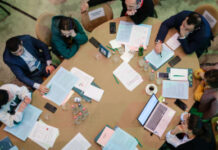NEW YORK — At the annual Symposium for Armenian Teachers at the Diocesan Center last month, educators heard presentations from a scholar of Armenian Studies and a veteran teacher on the ties between the Armenian language and faith, and focused on ways they could help students identify these connections in the classroom.
More than 70 participants representing 10 Diocesan Armenian schools in New York, New Jersey and Massachusetts attended the event on Saturday, September 12. The day’s program was organized by the Diocese’s Armenian Studies Coordinator Gilda Kupelian.
Dr. Roberta Ervine, professor of Armenian Studies at St. Nersess Armenian Seminary, spoke to educators about the origin of the Armenian alphabet and its close relationship with Christianity.
In addition to making it possible to translate the Bible into Armenian, the alphabet helped embed Christian terms in the Armenian language by associating certain letters with words like “God” and “Christ.”
For example, Ervine noted that the first letter of the alphabet — Ayb — is linked to the word “Asdvadz,” or “God.” Meanwhile Keh — originally the last letter of the Armenian alphabet — represents the cross and is associated with “Kristos,” or “Christ.”
Hovsep Melkonian, who has served as the principal of Hamasdegh Armenian Language School in Bethesda, Md., spoke about a teaching model he developed which scheduled Armenian and Sunday School classes on the same day.
Quoting Mkhitar of Sepastia’s saying, “I do not sacrifice my nation for my faith, nor my faith for my nation,” Melkonian explained how the model helped students make connections between Armenian language, religion and culture.









